Following Up After The Shot
By Shawn Carlock
 One of the more common questions I get after people watch one of my long range hunting videos is, "How do you get over there and find the animal?" Usually this question is followed by a story of a well placed long shot where the animal takes a good hit and moves some small distance from the point of impact and the hunter has a very difficult time of recovery. Although I've had a few misses over the years I have yet to lose a hit animal at distance. I follow up every shot that I or my spotter can not physically see impact somewhere else. I feel that if you cannot confirm a miss you need to follow it up to be sure. Now this means that sometimes you are crossing great distances to look for hair, faint blood trail or possible bullet impact. This is not always easy to locate but I have been very successful at it, here are some examples and tricks I have used in recovery of game.
One of the more common questions I get after people watch one of my long range hunting videos is, "How do you get over there and find the animal?" Usually this question is followed by a story of a well placed long shot where the animal takes a good hit and moves some small distance from the point of impact and the hunter has a very difficult time of recovery. Although I've had a few misses over the years I have yet to lose a hit animal at distance. I follow up every shot that I or my spotter can not physically see impact somewhere else. I feel that if you cannot confirm a miss you need to follow it up to be sure. Now this means that sometimes you are crossing great distances to look for hair, faint blood trail or possible bullet impact. This is not always easy to locate but I have been very successful at it, here are some examples and tricks I have used in recovery of game.
First and foremost in canyon country where I hunt primarily, recovery can start before taking the shot. I have many times held a shot waiting on the animal to pass area where spotting a missing bullet impact would be much easier. Now I don't take shots that I believe that I can miss, but I also believe in stacking the deck in my favor as much as possible.
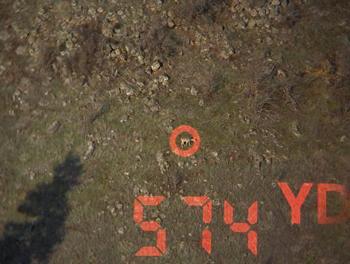
Excellent spotting background
A classic example of this happened about 3 years ago while I was spotting for a friend of mine for a shot on a whitetail buck. The buck a medium sized 4x5 was feeding around an overgrown skid road across a canyon at 639 yards. The road was overgrown with brush almost every where except a spot about 80-100 yards up the road from the deer where the road bank was a bare dirt patch. I directed my friend to the dirt patch and lazed it at 683 yards. He dialed in for the shot and we waited. Eventually the buck fed up to the bare spot and my friend took and made a great shot dropping the buck right where he stood (yes he was using an Edge).
My friend would have had to miss the buck by more then 10 feet in windage either way and 6 feet up or 2 feet down in elevation for me not to have been not able to spot a miss. Now had he hit and the buck ran, we would have had an easy point of impact spot to find when one of us got there to take up the trail. This how you can affect the outcome of your recovery efforts even before you take the shot.
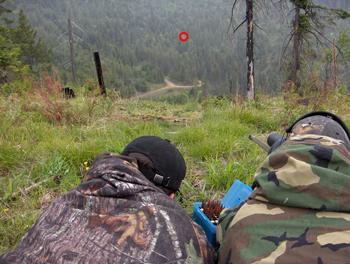
When shooting into pockets like this a spotter can make or break a recovery
Identifying and locating the point of impact is the key to recovery efforts where you cannot see the downed animal. Regardless of the direction I saw it run or the last point I saw it I always start at the point of impact.
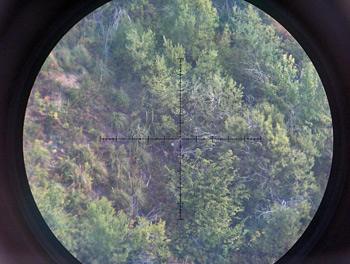
Spotting any miss here would be difficult
Now the direction of travel and last spot sighted are important but I don't just skip step A because I saw B & C. It would seem that spotting location A on the other side of the canyon and hiking over to it would be simple and sometimes it is. More often than not locating that exact spot is very difficult without some help.
Help can come in many forms, the easiest is to have a spotter with a hand held radio guide you to the spot. Even this can be made easier with a couple simple tips. I always carry a pair of hunter orange lightweight vests in my pack, one for the spotter and one for me. It always amazes me how well camouflage works even with your partner waving his arms around and jumping up and down. Even low light recoveries can be made with a spotter and the right preparation. I have a TMR reticule in my spotting scope and have walked a hunter to the downed animal by zooming back, centering the cross hair on the animal and putting a chemical light on the hunter. This will give you a pretty good shot a locating even in the dark if it is necessary. I don't attempt a dark recovery unless I am positive the animal is down. There is always good news/bad news is seems. The GN is that these techniques help a lot, the BN is these were easy 2 man recoveries. Having two guys always makes recovery easier.
On to tougher recoveries, 2 guys with an apparently good hit but the animal runs in to cover and disappears. Call the hit and stay with the spotting scope you can high five later. Immediately before any recovery attempt take good mental notes of impact sight and last known location. Watch any routes that could provide escape along the direction of travel. Now that you have given the proper amount of time send your tracker/shooter over and walk them to the point of impact.
Once they are there don't cloud their tracking ability by running your mouth about where you saw the animal last unless you see it moving. Let the tracker stay on the physical evidence, when they reach the point of last known location of the animal let them know, then just keep your eyes open and your mouth shut if you can. If they are on a good trail your in business, if there is no blood trail to follow (this can happen even with great hits) it will come down to tracking ability and the trackers ability to think like a mortally hit animal.
Now on to the toughest recoveries, these are solo recoveries. On solo recoveries you may or may not know for sure if you made a hit, a good hit or a miss and this is a huge disadvantage. Especially when by yourself make good mental notes about impact location before the shot is taken. After the shot your primary concern should be locating the direction of travel of the animal and potentially setting up for a follow up shot. Once the dust has settled priority one is to make sure you can locate the point of impact when you get to it. I try to pick a land mark that is impossible to miss, then when you get over there it will only be difficult instead of impossible to find. I try to find sights, a particular tree that I can line up with my position to locate my land mark.
I also hang my second orange vest at my shooting location so I can find it easy. Once I have a sight and/or at least a landmark, I make my best estimation on the point of impact location from that land mark. I also note the angle of the shot and distance (I can use my laser to tell if I am pretty close to the elevation). Armed with this information I set out for the point of impact.
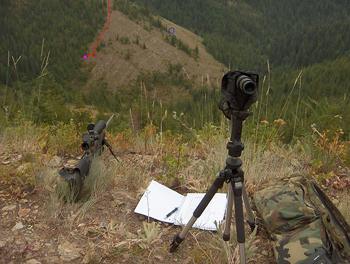
With a range finder and some landmarks you can keep from ending up at the blue circle location thinking you're at the red, it seems simple but distance and terrain change perceptions
Once I have located the area of the point of impact I start looking for any sign at all good or bad. There is almost always some hair, usually some blood splatter. Pay particular attention to the splatter pattern as it can give valuable clues as to the location of the hit if you weren't able to spot your own shot. Is the splatter from the impact side of the animal only? Is it on both sides? Does the exit side have a circular splatter pattern or is it V shaped? Is the splatter low to the ground or high? Are there bone fragments in it? What color is it? Are there any fluids in it other than blood? This info can mold how I will work the tracking process.
The first 20-30 feet of blood trail, or lack of, will tell you a lot about the hit. Is there blood on both side of the trail? Is there blood in the center of the trail? Is there blood on brush on the sides of the trail? How high up? Can I see tracks and scuff marks? Most often with a good hit there will be enough of a combo of the items to lead you right to your animal. What if I get to the POI and there is nothing except a scuff mark, no hair, no blood or other fluid, nothing? Well that is a real kick in the groin recovery but not impossible.
This is where thinking like a mortally hit animal comes into play. From the point of impact face the direction the animal was pointed when you shot or the direction you saw it go. If you have a point beyond the POI where you last saw it, do not skip this step. Follow the trail, tracks, scuff marks etc. until you reach the point where you last saw the animal. Stop and think about the direction of travel, the trail or path it took, was it random? Was it heading some where? Did it follow the contour? Did it take the path of least resistance? Seldom will mortally hit animals go uphill. Most will take off the direction they are pointed and follow the contour of the land or turn downhill or follow the contour and at some point turn downhill.
A huge key to this type of tracking is not to get into a big hurry, you only get one shot at a fresh tracking trail. If I run out of any kind of sign what so ever, I usually go back to the POI and do it again to see if I missed something. If I get to a point I am just sure it did not get past I start looking for trails or broken limbs etc. that go downhill if an animal starts to go down gets off the trail and then rolls they can go some distance sometimes especially bears. Following this kind of trail can be exhausting and time consuming but I believe that it is our responsibility to exhaust every possibility first.
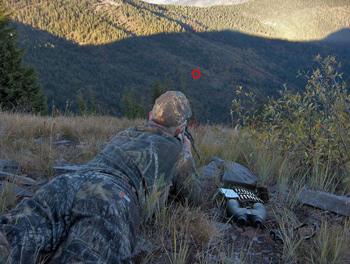
A dozen people won't make a recovery here any easier but a spotter will keep it from being impossible
I have recovered a couple of "bloodless" animals (most have left a well defined trail) using these techniques by myself. That doesn't mean that going solo is a great idea, long range hunting is kind of like being in a gunfight, your chances of success are much better if you have a solid partner.
By Shawn Carlock

First and foremost in canyon country where I hunt primarily, recovery can start before taking the shot. I have many times held a shot waiting on the animal to pass area where spotting a missing bullet impact would be much easier. Now I don't take shots that I believe that I can miss, but I also believe in stacking the deck in my favor as much as possible.

Excellent spotting background
A classic example of this happened about 3 years ago while I was spotting for a friend of mine for a shot on a whitetail buck. The buck a medium sized 4x5 was feeding around an overgrown skid road across a canyon at 639 yards. The road was overgrown with brush almost every where except a spot about 80-100 yards up the road from the deer where the road bank was a bare dirt patch. I directed my friend to the dirt patch and lazed it at 683 yards. He dialed in for the shot and we waited. Eventually the buck fed up to the bare spot and my friend took and made a great shot dropping the buck right where he stood (yes he was using an Edge).
My friend would have had to miss the buck by more then 10 feet in windage either way and 6 feet up or 2 feet down in elevation for me not to have been not able to spot a miss. Now had he hit and the buck ran, we would have had an easy point of impact spot to find when one of us got there to take up the trail. This how you can affect the outcome of your recovery efforts even before you take the shot.

When shooting into pockets like this a spotter can make or break a recovery
Identifying and locating the point of impact is the key to recovery efforts where you cannot see the downed animal. Regardless of the direction I saw it run or the last point I saw it I always start at the point of impact.

Spotting any miss here would be difficult
Now the direction of travel and last spot sighted are important but I don't just skip step A because I saw B & C. It would seem that spotting location A on the other side of the canyon and hiking over to it would be simple and sometimes it is. More often than not locating that exact spot is very difficult without some help.
Help can come in many forms, the easiest is to have a spotter with a hand held radio guide you to the spot. Even this can be made easier with a couple simple tips. I always carry a pair of hunter orange lightweight vests in my pack, one for the spotter and one for me. It always amazes me how well camouflage works even with your partner waving his arms around and jumping up and down. Even low light recoveries can be made with a spotter and the right preparation. I have a TMR reticule in my spotting scope and have walked a hunter to the downed animal by zooming back, centering the cross hair on the animal and putting a chemical light on the hunter. This will give you a pretty good shot a locating even in the dark if it is necessary. I don't attempt a dark recovery unless I am positive the animal is down. There is always good news/bad news is seems. The GN is that these techniques help a lot, the BN is these were easy 2 man recoveries. Having two guys always makes recovery easier.
On to tougher recoveries, 2 guys with an apparently good hit but the animal runs in to cover and disappears. Call the hit and stay with the spotting scope you can high five later. Immediately before any recovery attempt take good mental notes of impact sight and last known location. Watch any routes that could provide escape along the direction of travel. Now that you have given the proper amount of time send your tracker/shooter over and walk them to the point of impact.
Once they are there don't cloud their tracking ability by running your mouth about where you saw the animal last unless you see it moving. Let the tracker stay on the physical evidence, when they reach the point of last known location of the animal let them know, then just keep your eyes open and your mouth shut if you can. If they are on a good trail your in business, if there is no blood trail to follow (this can happen even with great hits) it will come down to tracking ability and the trackers ability to think like a mortally hit animal.
Now on to the toughest recoveries, these are solo recoveries. On solo recoveries you may or may not know for sure if you made a hit, a good hit or a miss and this is a huge disadvantage. Especially when by yourself make good mental notes about impact location before the shot is taken. After the shot your primary concern should be locating the direction of travel of the animal and potentially setting up for a follow up shot. Once the dust has settled priority one is to make sure you can locate the point of impact when you get to it. I try to pick a land mark that is impossible to miss, then when you get over there it will only be difficult instead of impossible to find. I try to find sights, a particular tree that I can line up with my position to locate my land mark.
I also hang my second orange vest at my shooting location so I can find it easy. Once I have a sight and/or at least a landmark, I make my best estimation on the point of impact location from that land mark. I also note the angle of the shot and distance (I can use my laser to tell if I am pretty close to the elevation). Armed with this information I set out for the point of impact.

With a range finder and some landmarks you can keep from ending up at the blue circle location thinking you're at the red, it seems simple but distance and terrain change perceptions
Once I have located the area of the point of impact I start looking for any sign at all good or bad. There is almost always some hair, usually some blood splatter. Pay particular attention to the splatter pattern as it can give valuable clues as to the location of the hit if you weren't able to spot your own shot. Is the splatter from the impact side of the animal only? Is it on both sides? Does the exit side have a circular splatter pattern or is it V shaped? Is the splatter low to the ground or high? Are there bone fragments in it? What color is it? Are there any fluids in it other than blood? This info can mold how I will work the tracking process.
The first 20-30 feet of blood trail, or lack of, will tell you a lot about the hit. Is there blood on both side of the trail? Is there blood in the center of the trail? Is there blood on brush on the sides of the trail? How high up? Can I see tracks and scuff marks? Most often with a good hit there will be enough of a combo of the items to lead you right to your animal. What if I get to the POI and there is nothing except a scuff mark, no hair, no blood or other fluid, nothing? Well that is a real kick in the groin recovery but not impossible.
This is where thinking like a mortally hit animal comes into play. From the point of impact face the direction the animal was pointed when you shot or the direction you saw it go. If you have a point beyond the POI where you last saw it, do not skip this step. Follow the trail, tracks, scuff marks etc. until you reach the point where you last saw the animal. Stop and think about the direction of travel, the trail or path it took, was it random? Was it heading some where? Did it follow the contour? Did it take the path of least resistance? Seldom will mortally hit animals go uphill. Most will take off the direction they are pointed and follow the contour of the land or turn downhill or follow the contour and at some point turn downhill.
A huge key to this type of tracking is not to get into a big hurry, you only get one shot at a fresh tracking trail. If I run out of any kind of sign what so ever, I usually go back to the POI and do it again to see if I missed something. If I get to a point I am just sure it did not get past I start looking for trails or broken limbs etc. that go downhill if an animal starts to go down gets off the trail and then rolls they can go some distance sometimes especially bears. Following this kind of trail can be exhausting and time consuming but I believe that it is our responsibility to exhaust every possibility first.

A dozen people won't make a recovery here any easier but a spotter will keep it from being impossible
I have recovered a couple of "bloodless" animals (most have left a well defined trail) using these techniques by myself. That doesn't mean that going solo is a great idea, long range hunting is kind of like being in a gunfight, your chances of success are much better if you have a solid partner.

